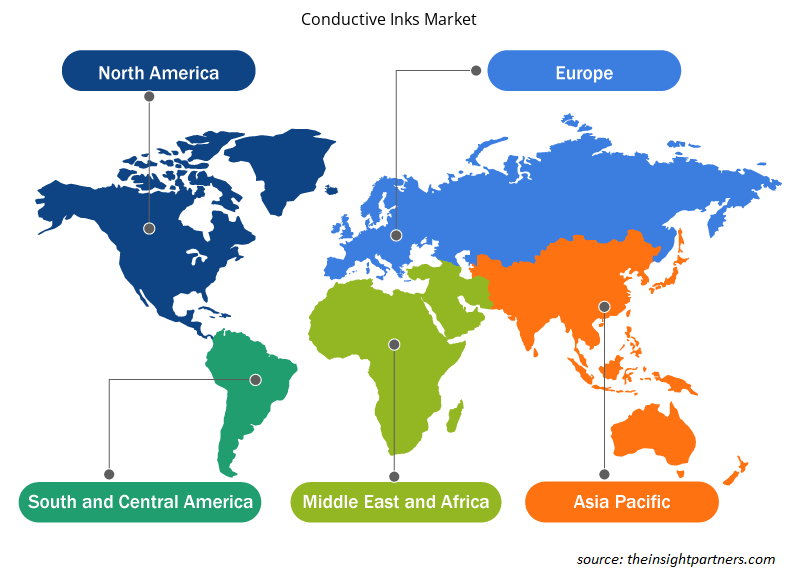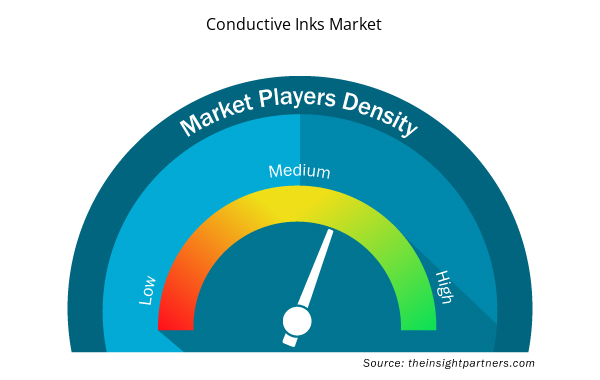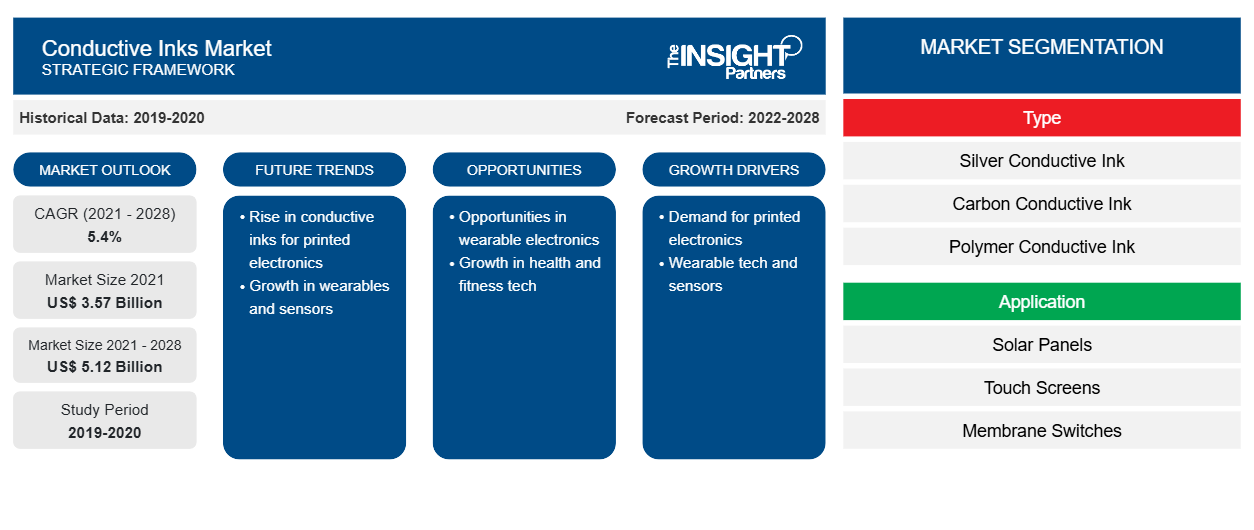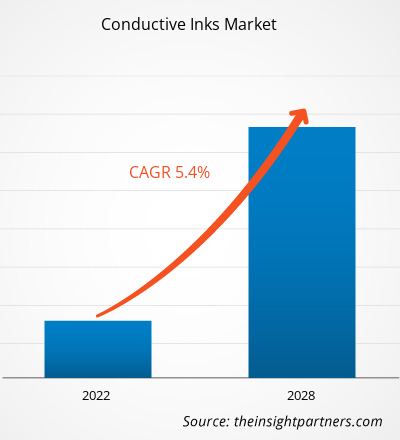[研究报告] 导电油墨市场预计将从 2021 年的 35.658 亿美元增长到 2028 年的 51.198 亿美元;预计 2022 年至 2028 年的复合年增长率为 5.4%。
世界各国政府都颁布了环境限制措施,鼓励行业用现代轻质材料取代设备中的重型材料。此外,消费者对微型和轻型电子产品的需求推动了消费电子行业对其产品的小型化。此外,快速增长的基于物联网的应用和日益增长的小型化趋势预计将推动对导电油墨市场的需求。智能手机 和联网设备的快速增长推动了对具有低功耗要求和增强性能的更小、更轻的传感器的需求,这刺激了对小型化的需求。中国主导着全球电子制造业的整个价值链,并正在大力投资新技术以快速制造小型化电子产品。因此,智能手机、可穿戴设备和其他设备对小型化的需求不断增长,对高效电子设备的需求不断增加,并增强了导电油墨市场 规模。
定制此报告以满足您的需求
您可以免费定制任何报告,包括本报告的部分内容、国家级分析、Excel 数据包,以及为初创企业和大学提供优惠和折扣
- 获取此报告的关键市场趋势。这个免费样品将包括数据分析,从市场趋势到估计和预测。
COVID-19 疫情对导电油墨市场的影响
由于 COVID-19 疫情,许多柔性和印刷电子行业面临劳动力短缺。印刷电子应用对导电油墨的需求,例如现代交通票中使用的 RFID 标签印刷和汽车挡风玻璃除霜器,正在促进导电油墨市场的增长。此外,汽车行业产量下降也对市场产生了负面影响。根据国际汽车制造商组织 (OICA) 的数据,2019 年和 2020 年全球所有汽车销量分别为 91,227,182 辆和 78,774,320 辆。因此,汽车销量下降对市场产生了负面影响,因为导电油墨用于汽车电路和印刷除霜器的应用,尤其是汽车后窗上的应用。然而,从 2021 年中期开始,石油开采项目的恢复正在推动导电油墨市场的增长。然而,在疫情爆发之前,北美汽车行业的增长、电动汽车普及率的提高以及人们对健康的认识不断提高,推动了对设备小型化的需求。消费电子行业已经实现了增长。此外,对小型轻便电子产品(如运动可穿戴手表)和用于监测健康的电子医疗设备的需求不断增长,这也推动了导电油墨市场的增长。
市场洞察 – 导电油墨市场
太阳能电池板安装量不断增长推动导电油墨市场增长
能源需求的增加使得人们不得不使用替代能源。因此,可再生能源,尤其是太阳能,现在正被用于发电。太阳能发电的日益普及预计将推动对太阳能技术的需求,并在未来几年增加太阳能电池板的部署。这将为光伏应用领域的导电油墨市场创造机会。使用喷墨打印,导电油墨可以在非常薄的柔性表面上印刷有机光伏太阳能电池板。太阳能(光伏)行业一直面临着巨大的压力,需要削减原材料成本并提高生产效率,以与现有的电网电力系统竞争。在这种情况下,导电油墨是该行业的潜在解决方案,从而推动导电油墨市场的发展。
基于类型的洞察
根据类型,导电油墨市场细分为银导电油墨、碳导电油墨、聚合物导电油墨、铜导电油墨等。碳导电油墨部分在 2021 年占据了最大的市场份额。碳导电油墨具有润滑性,摩擦力低,热稳定性好。该油墨用于丝网印刷、浸涂和注射器点胶,对玻璃和各种其他基材具有出色的附着力。与传统导电材料不同,碳油墨耐磨、耐刮擦、耐弯曲和耐折痕。印刷电子行业的快速增长促进了导电油墨的发展。碳基导电油墨的导电填料供应广泛、价格低廉、稳定性好,应用价值高。Nanoshel LLC、Henkel 和 Dycotec Materials Ltd 是碳导电油墨市场的主要参与者。这些参与者的存在促进了市场的增长。
导电油墨市场的参与者主要专注于开发先进、高效的产品。
- 2022 年,杜邦微电路和元件材料业务部宣布推出用于医疗保健应用的新型银/氯化银导电油墨/浆料 5881。
- 2021年,杜邦公司宣布成功完成对全球高性能电磁屏蔽和热管理解决方案领导者莱尔德性能材料公司的收购。
导电油墨市场区域洞察
Insight Partners 的分析师已详尽解释了预测期内影响导电油墨市场的区域趋势和因素。本节还讨论了北美、欧洲、亚太地区、中东和非洲以及南美和中美洲的导电油墨市场细分和地理位置。

- 获取导电油墨市场的区域特定数据
导电油墨市场报告范围
| 报告属性 | 细节 |
|---|---|
| 2021 年市场规模 | 35.7亿美元 |
| 2028 年市场规模 | 51.2亿美元 |
| 全球复合年增长率(2021 - 2028) | 5.4% |
| 史料 | 2019-2020 |
| 预测期 | 2022-2028 |
| 涵盖的领域 | 按类型
|
| 覆盖地区和国家 | 北美
|
| 市场领导者和主要公司简介 |
|
市场参与者密度:了解其对商业动态的影响
导电油墨市场正在快速增长,这得益于终端用户需求的不断增长,而这些需求又源于消费者偏好的不断变化、技术进步以及对产品优势的认识不断提高等因素。随着需求的增加,企业正在扩大其产品范围,进行创新以满足消费者的需求,并利用新兴趋势,从而进一步推动市场增长。
市场参与者密度是指在特定市场或行业内运营的企业或公司的分布情况。它表明在给定市场空间中,相对于其规模或总市场价值,有多少竞争对手(市场参与者)存在。
在导电油墨市场运营的主要公司有:
- 莫仕
- 杜邦
- 汉高股份公司
- Inkron(长濑集团)
- 墨水技术
免责声明:上面列出的公司没有按照任何特定顺序排列。

- 了解导电油墨市场主要参与者概况
导电油墨市场根据类型和应用进行细分。根据类型,市场细分为银导电油墨、碳导电油墨、聚合物导电油墨、铜导电油墨等。2021 年,碳导电油墨细分市场引领市场并占据最大市场份额。在应用方面,市场细分为太阳能电池板、触摸屏、薄膜开关、医疗设备、印刷电路板、传感器、加热元件、射频识别、手机天线、汽车等。2021 年,印刷电路板细分市场引领市场并占据最大市场份额。从地理上看,导电油墨市场大致分为北美、欧洲、亚太地区 (APAC)、中东和非洲 (MEA) 和南美 (SAM)。2021 年,亚太地区占据全球市场的很大份额。
Applied Ink Solutions;DuPont DE Nemours, Inc.;Henkel AG and CO. KGAA;Inkron OY;Inktec;Heraeus;Novacentrix;POLY-INK;Merck KGAA;和 Vorbeck Materials Corporation 是导电油墨市场的主要参与者。
- 历史分析(2 年)、基准年、预测(7 年)及复合年增长率
- PEST 和 SWOT 分析
- 市场规模价值/数量 - 全球、区域、国家
- 行业和竞争格局
- Excel 数据集



Report Coverage
Revenue forecast, Company Analysis, Industry landscape, Growth factors, and Trends

Segment Covered
This text is related
to segments covered.

Regional Scope
North America, Europe, Asia Pacific, Middle East & Africa, South & Central America

Country Scope
This text is related
to country scope.
常见问题
The top five key players operating in the conductive inks markets Dupont de Nemours, Inc., Henkel AG & Co. KGaA, NovaCentrix, MERCK KGaA, and Heraeus Holding GmbH are among the key players profiled in the research study on the conductive inks market. The companies engage themselves in designing and developing conductive inks with competitive pricing which enables the manufacturers to attract customers, thereby, gaining market share
Based on application, the conductive inks market is segmented into solar panels, touch screens, membrane switches, medical devices, printed circuit boards, sensors, heating elements, radio frequency identification, cell phone antennas, automotive glass, etc. The printed circuit board segment accounted for the largest share in the conductive inks market in 2021. A printed circuit board is a rigid structure that contains an electrical circuit made of embedded metal wires called traces and larger areas of metal called planes. The high-performance conductive inks and adhesive materials can withstand high-temperature processing used in the manufacture of printed circuit boards and are contributing to the market growth.
Based on type, the conductive ink market is segmented into silver conductive ink, carbon conductive ink, polymer conductive ink, copper conductive ink, and others. The carbon conductive ink segment accounted for a larger share of the conductive ink market in 2021. Carbon conductive inks are lubricious, providing low friction and excellent thermal stability. The development of conductive inks was aided by the rapid growth of the printed electronics sector. Carbon-based conductive inks' conductive fillers had a wide supply, low price, good stability, and a lot of application value.
The rising adoption of conductive ink in various applications sectors such as 5G, automotive photovoltaic, power electronics, package-level EMI shielding, In-Mold Electronics, electronic textile and wearable electronics, skin patches, RFID, and others. The automotive industry has been a key target market for conductive ink manufacturers. Printed defrosters, particularly on rear windows, are a typical application. The use of transparent and efficient large-area heating to minimize apparent defroster lines is an important development. In Furthermore, seat heaters are also a notable market with ample upside growth opportunities.
The use of conductive inks in printing RFID chips has several advantages, such as reduced size and fast and efficient production, resulting in low production costs. In addition, the RFID tag's antenna is used to distribute frequency signals and establish a wireless link between the tag and the reader. Traditional antenna manufacturing methods are expensive and have slow production speeds. Also, they pollute the environment. To address these drawbacks, the technology of printing antennas with conductive ink is being used. Thus, the growing adoption of RFID technology drives the conductive inks market growth.
Trends and growth analysis reports related to Electronics and Semiconductor : READ MORE..
The List of Companies - Conductive Inks Market
- Molex
- DuPont
- Henkel AG & Co. KGaA
- Inkron (Nagase Group)
- InkTec
- Heraeus
- NovaCentrix
- Poly-Ink
- Merck KGaA
- Vorbeck Materials Corporation
The Insight Partners performs research in 4 major stages: Data Collection & Secondary Research, Primary Research, Data Analysis and Data Triangulation & Final Review.
- Data Collection and Secondary Research:
As a market research and consulting firm operating from a decade, we have published and advised several client across the globe. First step for any study will start with an assessment of currently available data and insights from existing reports. Further, historical and current market information is collected from Investor Presentations, Annual Reports, SEC Filings, etc., and other information related to company’s performance and market positioning are gathered from Paid Databases (Factiva, Hoovers, and Reuters) and various other publications available in public domain.
Several associations trade associates, technical forums, institutes, societies and organization are accessed to gain technical as well as market related insights through their publications such as research papers, blogs and press releases related to the studies are referred to get cues about the market. Further, white papers, journals, magazines, and other news articles published in last 3 years are scrutinized and analyzed to understand the current market trends.
- Primary Research:
The primarily interview analysis comprise of data obtained from industry participants interview and answers to survey questions gathered by in-house primary team.
For primary research, interviews are conducted with industry experts/CEOs/Marketing Managers/VPs/Subject Matter Experts from both demand and supply side to get a 360-degree view of the market. The primary team conducts several interviews based on the complexity of the markets to understand the various market trends and dynamics which makes research more credible and precise.
A typical research interview fulfils the following functions:
- Provides first-hand information on the market size, market trends, growth trends, competitive landscape, and outlook
- Validates and strengthens in-house secondary research findings
- Develops the analysis team’s expertise and market understanding
Primary research involves email interactions and telephone interviews for each market, category, segment, and sub-segment across geographies. The participants who typically take part in such a process include, but are not limited to:
- Industry participants: VPs, business development managers, market intelligence managers and national sales managers
- Outside experts: Valuation experts, research analysts and key opinion leaders specializing in the electronics and semiconductor industry.
Below is the breakup of our primary respondents by company, designation, and region:

Once we receive the confirmation from primary research sources or primary respondents, we finalize the base year market estimation and forecast the data as per the macroeconomic and microeconomic factors assessed during data collection.
- Data Analysis:
Once data is validated through both secondary as well as primary respondents, we finalize the market estimations by hypothesis formulation and factor analysis at regional and country level.
- Macro-Economic Factor Analysis:
We analyse macroeconomic indicators such the gross domestic product (GDP), increase in the demand for goods and services across industries, technological advancement, regional economic growth, governmental policies, the influence of COVID-19, PEST analysis, and other aspects. This analysis aids in setting benchmarks for various nations/regions and approximating market splits. Additionally, the general trend of the aforementioned components aid in determining the market's development possibilities.
- Country Level Data:
Various factors that are especially aligned to the country are taken into account to determine the market size for a certain area and country, including the presence of vendors, such as headquarters and offices, the country's GDP, demand patterns, and industry growth. To comprehend the market dynamics for the nation, a number of growth variables, inhibitors, application areas, and current market trends are researched. The aforementioned elements aid in determining the country's overall market's growth potential.
- Company Profile:
The “Table of Contents” is formulated by listing and analyzing more than 25 - 30 companies operating in the market ecosystem across geographies. However, we profile only 10 companies as a standard practice in our syndicate reports. These 10 companies comprise leading, emerging, and regional players. Nonetheless, our analysis is not restricted to the 10 listed companies, we also analyze other companies present in the market to develop a holistic view and understand the prevailing trends. The “Company Profiles” section in the report covers key facts, business description, products & services, financial information, SWOT analysis, and key developments. The financial information presented is extracted from the annual reports and official documents of the publicly listed companies. Upon collecting the information for the sections of respective companies, we verify them via various primary sources and then compile the data in respective company profiles. The company level information helps us in deriving the base number as well as in forecasting the market size.
- Developing Base Number:
Aggregation of sales statistics (2020-2022) and macro-economic factor, and other secondary and primary research insights are utilized to arrive at base number and related market shares for 2022. The data gaps are identified in this step and relevant market data is analyzed, collected from paid primary interviews or databases. On finalizing the base year market size, forecasts are developed on the basis of macro-economic, industry and market growth factors and company level analysis.
- Data Triangulation and Final Review:
The market findings and base year market size calculations are validated from supply as well as demand side. Demand side validations are based on macro-economic factor analysis and benchmarks for respective regions and countries. In case of supply side validations, revenues of major companies are estimated (in case not available) based on industry benchmark, approximate number of employees, product portfolio, and primary interviews revenues are gathered. Further revenue from target product/service segment is assessed to avoid overshooting of market statistics. In case of heavy deviations between supply and demand side values, all thes steps are repeated to achieve synchronization.
We follow an iterative model, wherein we share our research findings with Subject Matter Experts (SME’s) and Key Opinion Leaders (KOLs) until consensus view of the market is not formulated – this model negates any drastic deviation in the opinions of experts. Only validated and universally acceptable research findings are quoted in our reports.
We have important check points that we use to validate our research findings – which we call – data triangulation, where we validate the information, we generate from secondary sources with primary interviews and then we re-validate with our internal data bases and Subject matter experts. This comprehensive model enables us to deliver high quality, reliable data in shortest possible time.


 获取此报告的免费样本
获取此报告的免费样本